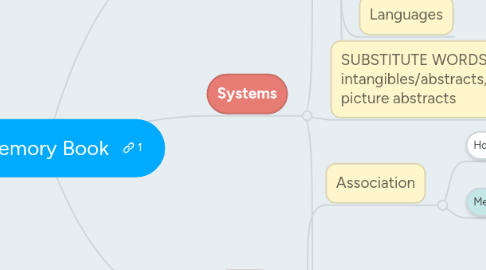
1. Applications
1.1. Studying
1.2. Speeches
1.3. Lists
1.3.1. Shooping
1.3.2. Numbers
1.3.3. States, etc.
1.4. Languages
1.5. Long words
2. Systems
2.1. Link
2.1.1. Ridiculous associations used to remember items in order/sequence
2.1.1.1. How?
2.1.1.1.1. Based on creating pictures/images and then creating a story with them.
2.1.1.1.2. Substitution - Picture one item instead of the other
2.1.1.1.3. Out of proportion - Seeing items larger than life
2.1.1.1.4. Exaggeration - Think of many
2.1.1.1.5. Action - Seeing your pictures in actions
2.1.1.2. Exercise: Link 10 items+actions in Sequence
2.2. SUBSTITUTE WORDS - How to make intangibles/abstracts, tangible; how to picture abstracts
2.2.1. When you hear word/phrase that's abstract/intangible - think of anything that can be pictured and sounds like/reminds you of the abstract/intangible
2.2.1.1. Creating a standard - Example: For repetitive stuff like North and South states, you can create something differentiates them. North can be a cannon, the South can be a dog; North Carolina can be A canon shooting off girls named Carol, a South Carolina can be a dog named Carol.
2.2.1.2. Something that sounds like - Example: Mini Soda sounds like Minnesota
2.2.1.3. Something that reminds you - Example: If you think of swamps or Disney land when you think of Florida picture that scene to remind you of Florida. Or picture congress when thinking of DC or a gigantic Apple when thinking of NY city
2.3. Key Words
2.3.1. Speeches/Lyrics/Reading Material/Lectures
2.3.1.1. Don't memorize word for word - memorize thought for thought
2.3.1.2. Talk it in your own words, THOUGHT FOR THOUGHT
2.3.1.3. Speech is a sequence of thoughts
2.3.1.4. Steps:
2.3.1.4.1. 0- Draft/brainstorm thoughts and ideas you want to cover
2.3.1.4.2. 1-Write out speech (all you think you want to say about all the ideas you think are important)
2.3.1.4.3. 2- Read it over to get gist
2.3.1.4.4. 3- Select a key word from each thought that will remind you of the entire thought
3. Science
3.1. Association
3.1.1. How things relate to one another
3.1.2. Memory is based on association
3.1.2.1. "You Can Remember Any New Piece of Information if It Is Associated to Something You Already Know or Remember in Some Ridiculous way"
3.2. Original Awereness
3.2.1. Cannot be forgotten
3.2.2. Steps:
3.2.2.1. 1- Search info/source(First observe)
3.2.2.2. 2- Deep understanding (Association, Questions, Mind Maps , etc.)
3.2.2.3. 3 - Memorize
3.2.2.4. 4 - Apply
3.2.3. Learning is based on association
